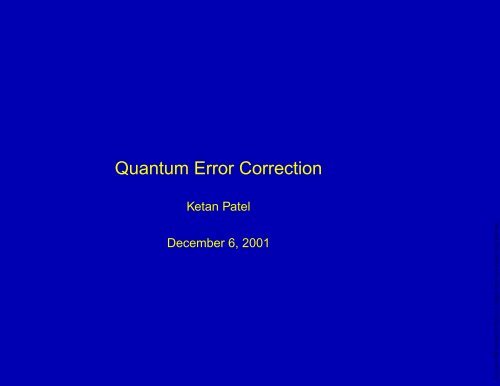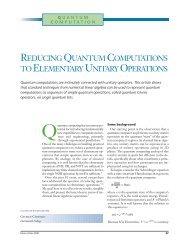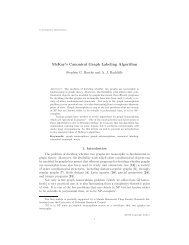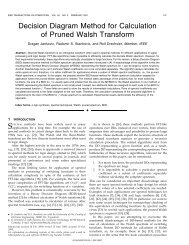Quantum Error Correction
Quantum Error Correction
Quantum Error Correction
You also want an ePaper? Increase the reach of your titles
YUMPU automatically turns print PDFs into web optimized ePapers that Google loves.
<strong>Quantum</strong> <strong>Error</strong> <strong>Correction</strong><br />
Ketan Patel<br />
December 6, 2001<br />
No license: PDF produced by PStill (c) F. Siegert - http://www.this.net/~frank/pstill.html
Outline<br />
• Motivation<br />
• Introduction to Classical <strong>Error</strong> <strong>Correction</strong><br />
• Examples of <strong>Quantum</strong> Codes<br />
• Properties of <strong>Quantum</strong> Codes<br />
• Stabilizer Codes<br />
• Fault Tolerant Computing<br />
• References .<br />
No license: PDF produced by PStill (c) F. Siegert - http://www.this.net/~frank/pstill.html
Motivation<br />
• Decoherence<br />
In practice sustaining entangled state is difficult<br />
• <strong>Error</strong> Build-up<br />
<strong>Quantum</strong> algorithms involve computations w/o intermediate measurements<br />
• Faulty Gates<br />
<strong>Quantum</strong> gates tend to be “noisy”.<br />
No license: PDF produced by PStill (c) F. Siegert - http://www.this.net/~frank/pstill.html
Classical <strong>Error</strong> <strong>Correction</strong> Codes<br />
p<br />
1-p<br />
0 0<br />
p<br />
1-p<br />
1 1<br />
Pe = p<br />
Binary Symmetric Channel<br />
Repetition Code<br />
{<br />
0 → 000<br />
1 → 111<br />
Decode by majority vote<br />
Bit flips in one out of three are correctable ⇒ Pe ∼ p 2<br />
...but rate reduced to 1 3 .<br />
No license: PDF produced by PStill (c) F. Siegert - http://www.this.net/~frank/pstill.html
Classical Codes (cont.)<br />
A code maps information bits to codewords<br />
Example:<br />
Info Bits Codewords<br />
0 0 → 0 0 0 0 0<br />
0 1 → 1 1 1 0 0<br />
1 0 → 0 0 1 1 1<br />
1 1 → 1 1 0 1 1<br />
The farther apart (Hamming distance) the codewords, the more errors can be corrected<br />
A code with minimum distance d corrects up to t = ⌊ d−1<br />
2 ⌋errors<br />
This code has length 5, encodes 2 info bits, and has minimum distance 3<br />
We say this is a [5,2,3] code .<br />
No license: PDF produced by PStill (c) F. Siegert - http://www.this.net/~frank/pstill.html
Linear Code Representations<br />
A code is linear if the sum of any two codewords is also a codeword<br />
Generator Matrix (G)<br />
Code is span of rows of G<br />
C =<br />
{xG for all x ∈ {0,1} k}<br />
Parity Check Matrix (H)<br />
Code is null space of H<br />
Hc = 0<br />
if and only if c ∈ C<br />
Example: for repetition code<br />
.<br />
n<br />
n<br />
{<br />
{[ }} {<br />
[ }} ][ { }<br />
][ } 1 1 0 1<br />
G = 1 1 1 k1<br />
H = n − k<br />
1 0 1 1<br />
No license: PDF produced by PStill (c) F. Siegert - http://www.this.net/~frank/pstill.html
<strong>Error</strong> <strong>Correction</strong> via Syndrome<br />
c - original codeword<br />
e - error vector (bits flipped by channel)<br />
Noisy codeword is c + e<br />
H(c + e) = He<br />
⇐ Syndrome<br />
Syndrome identifies error (which can then be corrected)<br />
Note: Syndrome independent of codeword<br />
Example: Repetition Code<br />
⎡<br />
[ ]<br />
1 1 0<br />
· ⎣ 0 ⎤<br />
[<br />
1 ⎦ 1<br />
=<br />
1 0 1<br />
0<br />
} {{ } 0<br />
H } {{ }<br />
c+e<br />
.<br />
] [<br />
1 1 0<br />
1 0 1<br />
⎡<br />
]<br />
· ⎣ 1 0<br />
1<br />
⎤<br />
⎦ =<br />
[<br />
1<br />
0<br />
]<br />
No license: PDF produced by PStill (c) F. Siegert - http://www.this.net/~frank/pstill.html
.<br />
<strong>Quantum</strong> Issues<br />
• No cloning |ψ〉 ⇒/ |ψ〉 ⊗ |ψ〉 ⊗ |ψ〉<br />
• Continuum of <strong>Error</strong>s e.g. α|0〉 + β|1〉 ⇒ α|0〉 + e iφ β|1〉<br />
• No Peeking! Measurement can collapse superpositions<br />
No license: PDF produced by PStill (c) F. Siegert - http://www.this.net/~frank/pstill.html
<strong>Quantum</strong> “Repetition” Code<br />
|0〉 → |000〉<br />
|1〉 → |111〉<br />
ψ<br />
0<br />
S1 S2 action<br />
0 0 none<br />
0 1 flip Q3<br />
1 0 flip Q2<br />
1 1 flip Q1<br />
So we can correct one bit flip<br />
But a single phase error<br />
|000〉 + |111〉<br />
} {{ }<br />
|0〉+|1〉<br />
anc1<br />
anc2<br />
[<br />
1 0<br />
0 −1<br />
0<br />
0<br />
0<br />
]<br />
⇒ |000〉 − |111〉 .<br />
} {{ }<br />
|0〉−|1〉<br />
is uncorrectable:<br />
S1<br />
S2<br />
No license: PDF produced by PStill (c) F. Siegert - http://www.this.net/~frank/pstill.html
Phase-Flip Code<br />
Phase Flips in Hadamard domain<br />
⇕<br />
Bit Flips<br />
ψ<br />
0<br />
0<br />
H<br />
H<br />
H<br />
H<br />
H<br />
H<br />
anc1 0<br />
ψ H Z<br />
H anc2 0<br />
ψ<br />
X<br />
So we can correct one phase flip But now bit flip is uncorrectable!<br />
.<br />
No license: PDF produced by PStill (c) F. Siegert - http://www.this.net/~frank/pstill.html
Shor [[9,1,3]] Code<br />
Concatenate Bit-flip and Phase-flip codes<br />
Bit flips are corrected by inner code<br />
Phase flips are corrected by outer code<br />
ψ<br />
0<br />
H<br />
H<br />
0<br />
0<br />
Example:<br />
Phase flip on Q1-3 ≡ Phase flip on Q1<br />
This can be corrected by the outer code<br />
But what about errors other than bit-flips & phase-flips...<br />
0<br />
H<br />
0<br />
0<br />
0<br />
0<br />
No license: PDF produced by PStill (c) F. Siegert - http://www.this.net/~frank/pstill.html
<strong>Error</strong> Discretization<br />
Four operations form a basis for all 2 × 2 matrices:<br />
. X - Bit-Flips Z - Phase-Flips<br />
Y - Combined Bit/Phase-Flips I - No <strong>Error</strong><br />
Therefore if we can correct these, we can correct any single qubit error<br />
Intuition: Measuring the error forces it to discretize!<br />
Similarly {E a } ≡ {I,X,Y,Z} ⊗n form a basis for errors on n qubits<br />
The weight of an error is the number of qubits acted on by X,Y, or Z<br />
So a t-error correcting code corrects all weight ≤ t errors .<br />
No license: PDF produced by PStill (c) F. Siegert - http://www.this.net/~frank/pstill.html
Conditions for a <strong>Quantum</strong> Code<br />
• Must not confuse two codewords even in presence of errors<br />
〈c 1 |E † F|c 2 〉 = 0 (for 〈c 1 |c 2 〉 = 0)<br />
<strong>Error</strong>s map orthogonal subspaces to orthogonal subspaces<br />
• Measurement must not reveal info about codewords<br />
〈c 1 |E † F|c 1 〉 = 〈c 2 |E † F|c 2 〉<br />
The error subspaces must “look” the same for all codewords<br />
These conditions are both necessary and sufficient<br />
.<br />
No license: PDF produced by PStill (c) F. Siegert - http://www.this.net/~frank/pstill.html
Stabilizers<br />
Define G n as the Pauli Group on n qubits<br />
G n ≡ {±I,±iI,±X,±iX,±Y,±iY,±Z,±iZ} ⊗n<br />
All elements of G n either commute or anticommute<br />
An operator O ∈ G n stabilizes a state ψ if<br />
O|ψ〉 = |ψ〉<br />
Let S ⊂ G n and V S set of states stabilized by every element in S<br />
V S = {ψ : s|ψ〉 = |ψ〉 for all s ∈ S}<br />
S is the stabilizer of the vector space V S<br />
Can consider V S a stabilizer code<br />
Independent set {g 1 ,...,g i } generates S .<br />
No license: PDF produced by PStill (c) F. Siegert - http://www.this.net/~frank/pstill.html
Stabilizer Codes<br />
Generators are analogous to rows of the parity check matrix<br />
g i |c〉 = |c〉 but g i E|c〉 = −Eg i |c〉 = −E|c〉<br />
Measuring eigenvalues of generators gives syndrome<br />
Example: [[9,1,3]] Shor Code<br />
Phase flip in Q3 (I ⊗ I ⊗ Z ⊗ I ⊗ I ⊗ I ⊗ I ⊗ I ⊗ I)<br />
has syndrome (Recall ZX = −XZ)<br />
[<br />
1 1 1 1 1 1 −1 1<br />
] t<br />
Note: Phase flip in Q1 gives same syndrome<br />
.<br />
Operator<br />
g1 Z Z I I I I I I I<br />
g2 I Z Z I I I I I I<br />
g3 I I I Z Z I I I I<br />
g4 I I I I Z Z I I I<br />
g5 I I I I I I Z Z I<br />
g6 I I I I I I I Z Z<br />
g7 X X X X X X I I I<br />
g8 I I I X X X X X X<br />
No license: PDF produced by PStill (c) F. Siegert - http://www.this.net/~frank/pstill.html
Fault-Tolerant Computing<br />
<strong>Error</strong>s can be introduced during computation<br />
Fault-tolerance: Single failure in any component causes at most one error in<br />
each encoded block of qubits at output<br />
Uncorrectable error occurs only if > 1 components fails<br />
If probability of component failure is p, then overall error probability is ∼ cp 2<br />
FT elementary operations & FT error correction ⇒ FT circuit .<br />
No license: PDF produced by PStill (c) F. Siegert - http://www.this.net/~frank/pstill.html
Fault-Tolerant Logic<br />
Sufficient set of fault-tolerant procedures<br />
• FT Hadamard gate<br />
• FT phase gate<br />
• FT C-NOT gate<br />
• FT π/8 gate<br />
⎫<br />
⎪⎬<br />
⎪⎭<br />
• FT Measurement<br />
• FT State Preparation<br />
Universal Set<br />
Implementation of fault-tolerant procedures dependent on error correction code<br />
For [[7,1,3]] Steane Code<br />
Bitwise implementation of Hadamard, phase, and C-NOT gates is fault-tolerant<br />
.<br />
No license: PDF produced by PStill (c) F. Siegert - http://www.this.net/~frank/pstill.html
Concatenation<br />
Recursively replace components with FT components & qubits with encoded qubits<br />
Original circuit:<br />
error occurs if single component fails: P f ∼ p<br />
Apply procedure once:<br />
error occurs if fault-tolerant component fails<br />
⇒two of its components fail: P f ∼ cp 2<br />
Apply procedure twice:<br />
error occurs if fault-tolerant fault-tolerant component fails<br />
⇒two of its fault-tolerant components fail<br />
⇒two of their components fail: P f ∼ c · (cp 2 ) 2<br />
If we concatenate k times<br />
while circuit size scales by ∼ d k<br />
Probability of Failure ∼ (cp) 2k /c<br />
No license: PDF produced by PStill (c) F. Siegert - http://www.this.net/~frank/pstill.html
Threshold Theorem<br />
If p < p th ≡ 1/c , a circuit with N gates can be simulated with probability of<br />
error at most ε using only<br />
O(poly(logN/ε)N) ⇐ polylogorithmically larger circuit<br />
gates.<br />
Threshold is p th ≈ 10 −5 –10 −6<br />
.<br />
No license: PDF produced by PStill (c) F. Siegert - http://www.this.net/~frank/pstill.html
Application to Factoring<br />
Factoring a 130 digit number (few months on classical)<br />
<strong>Quantum</strong> algorithm takes ∼ 2150 qubits and ∼ 3 · 10 9 Toffoli gates<br />
[Preskill 97]: Estimates factor of ∼ 343 increase for FT implementation<br />
[Steane 98]: Estimates factor of ∼ 10 increase<br />
.<br />
No license: PDF produced by PStill (c) F. Siegert - http://www.this.net/~frank/pstill.html
References<br />
• Neilsen & Chuang - <strong>Quantum</strong> Computation and <strong>Quantum</strong> Information<br />
• MacWilliams & Sloan - The Theory of <strong>Error</strong>-<strong>Correction</strong> Codes<br />
• Gottesman - An Introduction to <strong>Quantum</strong> <strong>Error</strong> <strong>Correction</strong> (2000)<br />
quant-ph/0004072<br />
• Preskill - Reliable <strong>Quantum</strong> Computers (1997)<br />
quant-ph/9705031<br />
• Steane - Efficient fault-tolerant quantum computing (1998)<br />
quant-ph/980954.<br />
No license: PDF produced by PStill (c) F. Siegert - http://www.this.net/~frank/pstill.html




![pdf [1 slide per]](https://img.yumpu.com/44496330/1/190x146/pdf-1-slide-per.jpg?quality=85)



